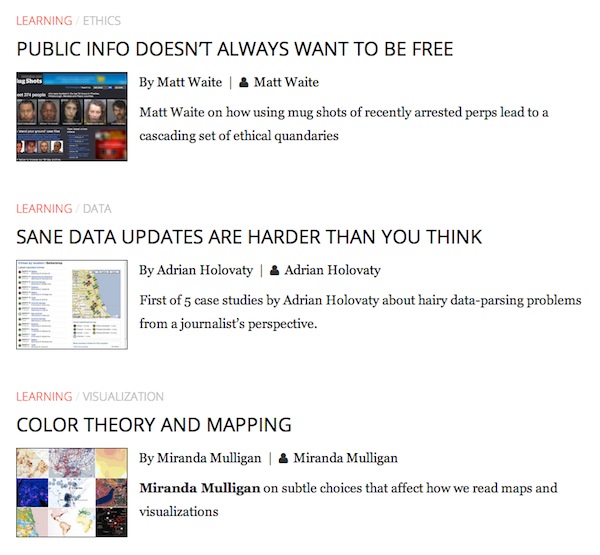If you ever wanted an “Ask This Old House”-style guide set in the universe of newsroom developers and designers, today you’re in luck: OpenNews Learning is a new kind of online education project that looks at the nuts and bolts of interactive projects through the eyes of the people who built them. It’s the newest arm of Knight-Mozilla OpenNews, the two-foundation collaboration that aims to strengthen the bonds between the worlds of journalism and software development.
One of the central ideas behind OpenNews is sharing knowledge, through building community and by putting outside developers directly into newsrooms. OpenNews Learning is an extension of that, designed to help developers (aspiring and otherwise) learn how specific projects were built. Consider it another way to “show your work.”
“I really see a major part of what we do at OpenNews is to pull back the curtain on how code works in journalism,” its head, Dan Sinker, told me.
 OpenNews Learning will be made up of a series of case studies on Source, OpenNews’ hub for information and community for developers, designers, and editors. The idea, Sinker said, is for the case studies to provide as much detail as is reasonably possible — from the original concept to the build to launch, with all the problems and obstacles in between. One of the first is written by Matt Waite, head of the drone journalism program at the University of Nebraska, about his experience creating one of the first police mugshot applications when he was with the St. Petersburg Times (now the Tampa Bay Times).
OpenNews Learning will be made up of a series of case studies on Source, OpenNews’ hub for information and community for developers, designers, and editors. The idea, Sinker said, is for the case studies to provide as much detail as is reasonably possible — from the original concept to the build to launch, with all the problems and obstacles in between. One of the first is written by Matt Waite, head of the drone journalism program at the University of Nebraska, about his experience creating one of the first police mugshot applications when he was with the St. Petersburg Times (now the Tampa Bay Times).

The first three pieces from OpenNews Learning.
Using case studies allows OpenNews Learning to teach by example and provide thorough, insider information, said Kio Stark, who is leading the project. Stark said the case studies can be more effective than coursework because they’re personal and contextual: Rather than read through an antiseptic description of a technology stack, you’ll get the writers candid thoughts and questions. The cases will also have plenty of links to apps, databases, and other source material. “We focused on doing them this way because it makes transparent the thought process and the build process and the places where those kind of challenges are encountered,” Stark told me.
The case studies will cover a number of categories, like data analysis, mapping, and data visualization. The lineup of writers include people like Jacob Harris of The New York Times, Miranda Mulligan of Northwestern’s Knight Lab, and Adrian Holovaty, founder of EveryBlock. New cases will be released regularly over the next four months of a total of 50, Stark said.
Despite the fact that the bulk of OpenNews Learning’s programming will come from people working in and around journalism, the audience isn’t intended to be restricted to those who’ve seen the inside of a newsroom. Quite the opposite, Stark said: “We are not aiming at developers working in newsrooms, but developers interested in the space of civic data and drawing them into some of the problem sets of journalism.”
That fits in with the broader goals of OpenNews, which wants to foster the growth of a broader community of hackers active in news or areas that are journalism-adjacent. That’s one of the reasons OpenNews Learning is going to live on Source, where it will compliment the discussion and code already being shared. Sinker said Learning was originally going to be another independent arm of OpenNews, alongside the Knight-Mozilla Fellowships, hack days, and other programs. Sinker said the growth of Source shows that the ranks of the hacker-journalist are growing. OpenNews Learning can only help reinforce that.
“A lot of what motivated the overall additional community emphasis of OpenNews was the realization that this community of people writing code in journalism is, to borrow an overworked term, at a tipping point,” he said.